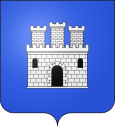Anduze
|
Anduze Andusa |
||
|---|---|---|

|
|
|
| region | Occitania | |
| Department | Gard | |
| Arrondissement | Alès | |
| Canton | Alès-1 | |
| Community association | Alès agglomeration | |
| Coordinates | 44 ° 3 ′ N , 3 ° 59 ′ E | |
| height | 117-443 m | |
| surface | 14.60 km 2 | |
| Residents | 3,436 (January 1, 2017) | |
| Population density | 235 inhabitants / km 2 | |
| Post Code | 30140 | |
| INSEE code | 30010 | |
| Website | www.mairie-anduze.com | |
 Anduze |
||
Anduze ( Occitan Andusa , Latin Andusia ) is a French commune with 3436 inhabitants (as of January 1, 2017) in the Gard department in the Occitanie region ; it belongs to the arrondissement of Alès and the canton of Alès-1 .
geography
Anduze is located on the southern edge of the Cevennes in the Gardon Valley , which is also called Gardon d'Anduze here .
The communes bordering Anduze are Boisset-et-Gaujac , Corbès , Générargues , Saint-Félix-de-Pallières (point of contact), Thoiras and Tornac in the same department.
|
Thoiras Corbès |
Générargues | Boisset-et-Gaujac |
|
Corbès Thoiras |

|
Boisset-et-Gaujac |
| Saint-Félix-de-Pallières | Tornac |
Boisset-et-Gaujac Tornac |
history
The dolmen of Claie-de-Driolle 2 - 8 are located roughly north of Saint-Félix-de-Pallières , west of Anduze.
The Anduze rule, established in the 10th century, was one of the oldest and most powerful in Languedoc . The Lords of Anduze were allied with the Counts of Toulouse and took part in the Albigensian Crusade . In 1266 the Anduze rule fell to the crown, but the place remained the seat of a bailiff .
Anduze is the cradle of sericulture in France, which was cultivated here from the end of the 13th century. The place became the regional center of the silk and wool trade.
In the 16th and 17th centuries, Anduze was an important center of Protestantism in the Cevennes . The fortified site, inhabited by 6,000 people in 1570, became the headquarters of the Protestant forces in southern France. In 1622 it was the base of the resistance of the Rohan , but was stripped of its city walls after the grace edict of Alès .
In the 19th century, Anduze experienced a renewed economic boom with the Industrial Revolution (silk moths, stocking makers, hat makers), but later - like the entire Cevennes - fell into another recession .
Population development
- 1962: 2988
- 1968: 3027
- 1975: 2723
- 1982: 2787
- 1990: 2913
- 1999: 3003
- 2008: 3289
- 2016: 3484
Attractions
- The Tour de Pézène , part of the former Château de Pézène , residence of the Counts of Beaufort in the 15th and 16th centuries; the tower is from the 13th-14th centuries Century.
- The Château Neuf , a two-tower manorial seat from the 17th century, which was built into the Remparts.
- The barracks, built on the Plan de Brie in 1740 to house the royal troops - now the Mairie and the Office de Tourisme.
- The Church of St Etienne; Erected from 1686 to 1688, after the previous building was destroyed in the same place after the revocation of the Edict of Nantes in 1685. The bell tower dates from 1588.
- The temple, one of the largest in France; it was built in the barracks courtyard from 1820 to 1823.
- The Tour de l'Horloge from 1320 and the Méridienne , the city clock since 1569; the tower has three floors in the same architecture as the Remparts of Aigues-Mortes ; he and the clock were spared in 1629 when the city walls were destroyed; the Méridienne was restored in 1989.
- The Place couverte from 1457, called “l'Orgerie” or “Marché aux grains”, the former chestnut market and today's weekly market.
- The Bambouseraie de Prafrance , a unique exotic garden 2 km north of Anduze.
- A museum railway that runs several times a day, steam train from the Cevennes along the Gardon valley to Saint-Jean-du-Gard, about 10 km away as the crow flies .
- A few kilometers from Anduze is the Trappist convent de la Paix-Dieu - Cabanoule in a tranquil natural landscape .
Web links
- Anduze municipality
- Office you tourisme
- Photos by Anduze
- Anduze on the Insee website
- German-language website anduze-info.com Anduze in southern France - the gateway between Provence and the Cevennes
- Website of the Trappist convent Cabanoule
- Maximilian Ihm : Andusia . In: Paulys Realencyclopadie der classischen Antiquity Science (RE). Volume I, 2, Stuttgart 1894, Col. 2175.

